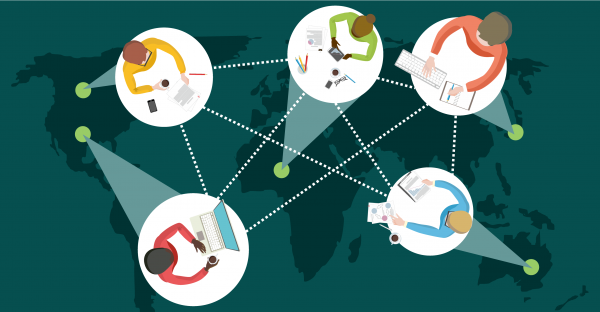Introduction
Work from home is a reality that all of us have come to accept with time, and during this time we have realized both the advantages and disadvantages that come with remote workspaces. One of the most common disadvantages people experience is their shared inability to collaborate effectively. When working online, people lack a shared mechanism of collaboration that enables them to visualize information together. Work from home has pushed people to adopt new and innovative technologies in order to keep up with the level of collaboration that is required, which leads them to adopt visual collaboration tools and online whiteboards.
Using these tools effectively changes how people collaborate online and how they think about collaboration going forward. In this article we will outline the 3 biggest ways that work from home has fundamentally changed collaboration. If you are interested in learning more about online collaboration and virtual workspaces, check out the Fresco blog.
Read more: The impact of UX during the COVID-19 Pandemic

Work From Home Innovations
Work from home has many benefits behind the veil of being remote, and employers should seek to maximize the benefits that work from home has to offer.
One of the biggest downsides of working from home, according to Forbes, is that people feel discouraged and disconnected from their team, and they struggle to communicate with each other. In order for people to collaborate effectively, then, collaboration must derive new features and new possibilities in order to work properly. Here are the three biggest ways that work from home has changed how people collaborate.
Change #1 — Methods of Collaboration
Work from home can be very stifling to the collaborative process, and for some, it has halted it altogether. People need to be creative in order to mitigate the disadvantages that can come with working from home. They need a creative tool to do so.
Work from home has forced virtual whiteboards into the hands of people everywhere, and these tools give them the creative boost they need in order to engage in productive collaboration sessions.
When using online whiteboards, you are able to pivot back and forth between multiple different workflows, effectively transitioning ideas through the collaborative process. You are also able to use multiple different methods of engagement to captivate the collaborative potential of your team and push it past what was previously possible.
For example, if you’re working on a large brainstorming session and want to just focus on a specific bucket, the focus view feature on virtual whiteboards allows you to do that. Or, if you are trying to map out multiple different options of flows and sticky notes just aren’t doing the trick, you can insert easy to use elements like flow charts, which you can expand and manipulate to your liking. These changes and interactions allow you to pivot in any way that is most beneficial to your current task, and engage the full collaborative potential of your entire team.
Being able to use multiple different methods of interaction is a critical advancement prompted by work from home technologies and fundamentally changes the way people collaborate.

Change #2 — Knowledge Permanence
While work from home creates a lot of difficulty around collaboration, it forces you to pivot to technologies and applications that create substantial benefits for collaboration. One of the benefits provided is the retention of important knowledge and takeaways in digital permanence.
This is a big change from traditional collaboration, where everyone is independently reliant on following up on the important takeaways.
When collaborating through virtual whiteboards, due to the separated nature of work from home, people can now disregard the lack of permanence posed by traditional collaboration. Online tools create spaces where people are enabled to work without fear of forgotten or lost knowledge. Everything you achieve and complete is now made permanent in an online database, accessible by all the contributors.
Knowledge permanence is something that has plagued collaboration and workshops for a long time. It’s easy to create a spark of innovation or point of brilliance during a brainstorming session, but implementing that into your everyday work becomes much harder when there isn’t a permanent, accessible record of it.
Also, with virtual workshops, people often feel really inspired with their takeaways and the learning they got from the workshop. However, after a couple of months, even weeks down the road, most people have forgotten the important mission of the workshop in the first place.
Whether it’s implementing innovations into your everyday practices or reminding yourself of important realities, having a record of your collaboration sessions is something that is only possible through the tools that work from home has placed on the table.

Change #3 — Constant Accessibility
Work from home has changed many things about the professional world, and one the most glaring changes is the physical accessibility. When people aren’t able to go into the office, they need a substitute in order to make up for the lost collaboration in the workplace.
Before work from home became routine, people didn’t think it was possible to engage in collaboration with people across the world. Thanks to virtual workspaces, however, this and much more is now possible.
Virtual workspaces make collaboration with people from anywhere, and in any time zone as simple as a click. Not only does work from home enable a geographic expansion of collaboration, but one that expands accessibility to different times.
As we have already learned, collaborating online creates permanent records of all your boards and achievements. This permanence is a massive catalyst for future collaboration, especially on boards/works that are ongoing. When you can access your collaborative space at any convenient time, you are never limited as to when you can expand an idea, share feedback, or analyze your results. This accessibility is profound compared to the lack thereof through traditional collaboration methods.
Accessibility, not just through distance but through time as well, is a massive way that work from home has changed how people think about collaboration.

Conclusion
Collaboration is a critical activity for people to operate in their workspaces effectively, and it’s something that is surrounded by a lot of question marks due to work from home. While there are some downsides related to working from home, it also allows you to utilize innovative technologies that expand the potential of your team. In review, here are the three biggest ways work from home has changed collaboration.
- Methods of Collaboration — Through shared online tools you are able to quickly pivot between workflows and manipulate unique visual elements, something that isn’t possible traditionally.
- Digital Permanence — Work from home enables you to use tools that create permanent records of your collaboration and achievements, meaning you never have to lose important knowledge ever again.
- Constant Accessibility — Work from home means you need flexibility, and the tools you use allow you to access your collaborative space at anytime, from anywhere.
Banking on Bad UX vol. 2: The 1s and 0s of a $900,000,000 UI mistake
This post was contributed by Fresco — Fresco is a startup focused on providing unique visual collaboration solutions and expanding the potential of virtual whiteboards.






